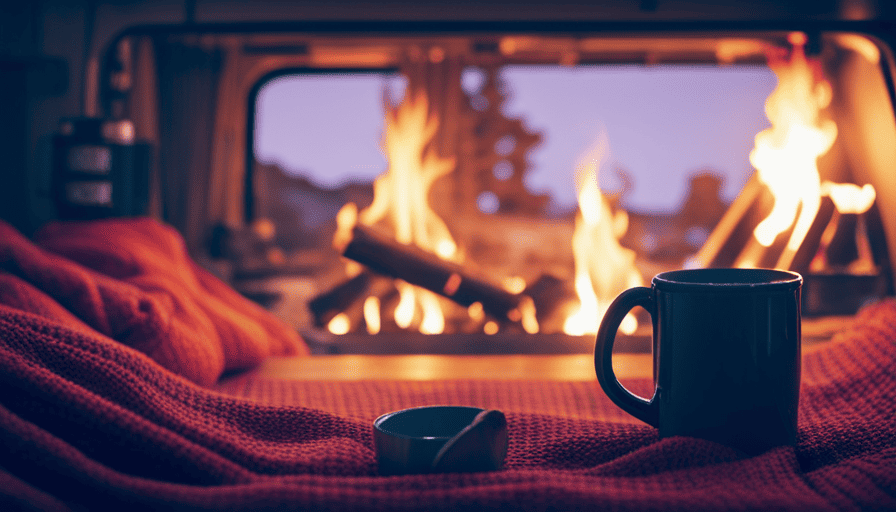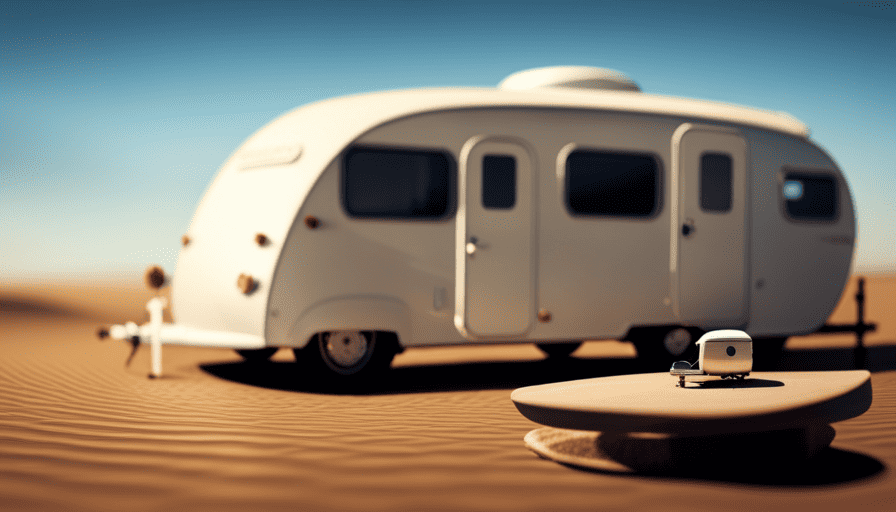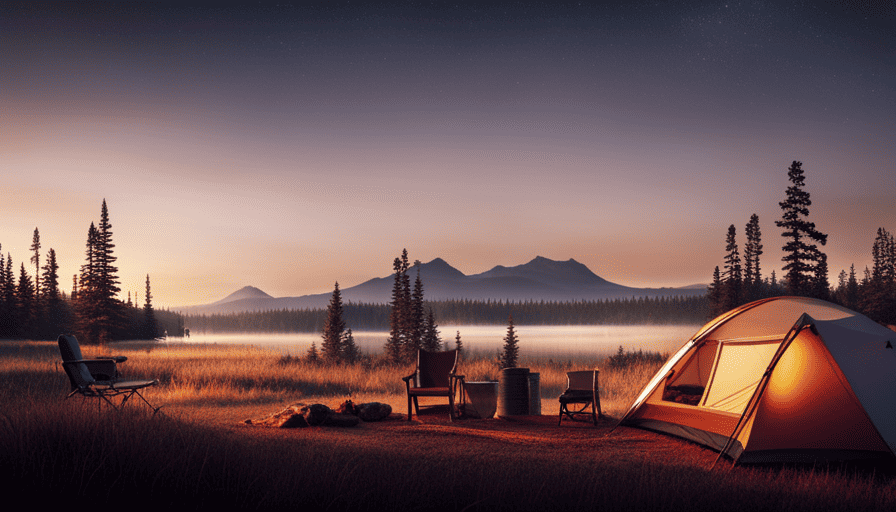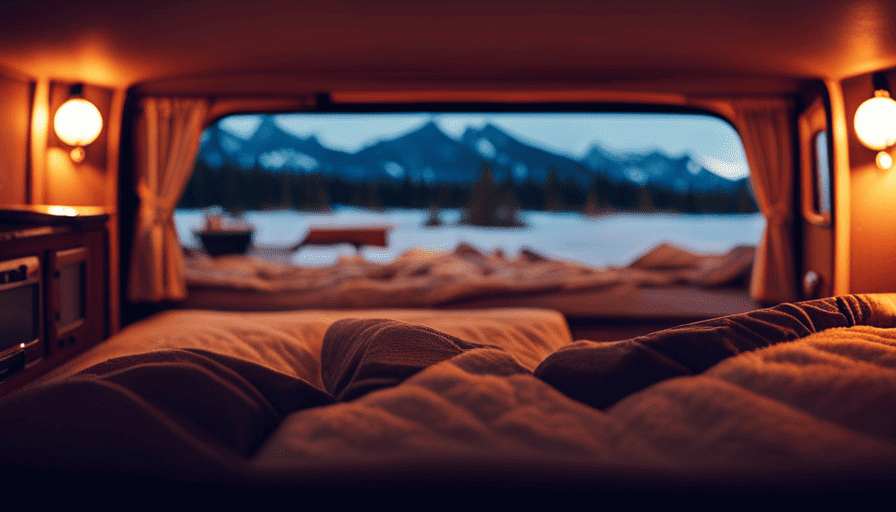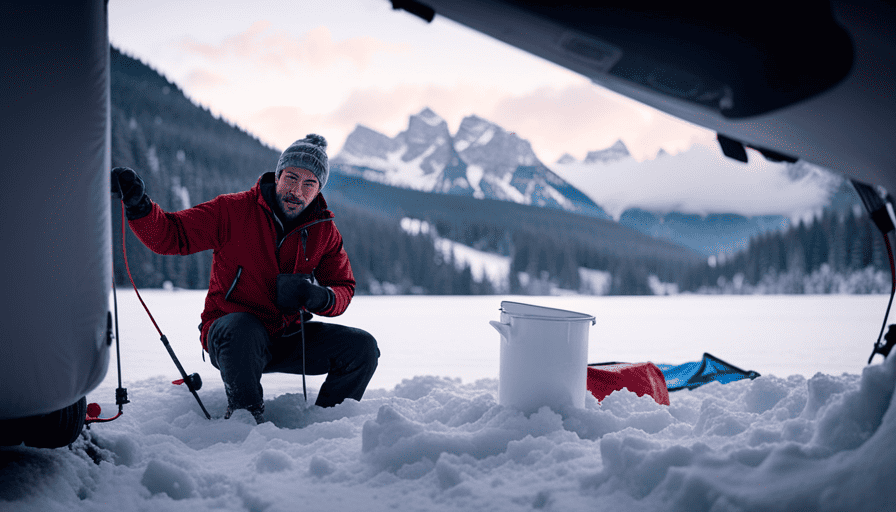Did you know that heating a camper during the winter could cost you up to $500 per month?
That’s right! As an avid winter camper, I understand the importance of staying warm and comfortable during those chilly nights. In this article, I will provide you with all the information you need to know about the cost of heating a camper in the winter.
First, we will explore the different types of heating systems available for campers, including propane, electric, and wood-burning options.
Then, I will guide you through the process of calculating fuel costs based on your camper’s size and energy efficiency.
Additionally, I will discuss the importance of properly insulating your camper to minimize heat loss and reduce heating expenses. We will also cover the topic of proper ventilation to ensure safety and prevent condensation buildup.
Furthermore, I will share energy-efficient practices and solar power options that can help you save money on heating expenses. Budgeting for winter camping expenses and considering safety precautions will also be discussed.
Lastly, we will explore alternative heating methods that can be more cost-effective and environmentally friendly.
So, if you’re ready to learn how to keep your camper warm without breaking the bank, let’s dive in!
Key Takeaways
- Heating a camper in the winter can cost up to $500 per month.
- Propane furnaces are efficient but require regular maintenance.
- Proper ventilation is important for maintaining a healthy indoor environment and preventing mold and mildew growth.
- Insulating the camper floor minimizes heat loss and creates a more comfortable living space.
Types of Heating Systems for Campers
So, you’re wondering what types of heating systems you can use to keep your camper cozy during those chilly winter months? Well, there are several options available to you, each with its own advantages and considerations.
One popular choice is a propane furnace, which uses propane gas to generate heat. These furnaces are efficient and provide a consistent source of warmth, but they do require regular maintenance to ensure they’re functioning properly.
Another option is a diesel heater, which uses diesel fuel to produce heat. These heaters are known for their efficiency and can often be more cost-effective than propane furnaces. However, they do require regular maintenance and can be noisy.
Additionally, you can consider electric heaters, which are convenient and easy to use. They don’t require any fuel and can be plugged into a power source. However, they may not be as efficient as other options and can be expensive to operate.
When choosing a heating system for your camper, it’s important to consider factors like calculating efficiency and maintenance requirements. This will help you determine the best option for your needs and budget.
Now, let’s move on to calculating fuel costs.
Calculating Fuel Costs
To keep your cozy home on wheels warm during the chilly season, it’s essential to calculate the fuel expenses for heating. Calculating energy usage is an important step in determining the most cost-effective fuel type for your camper.
The first thing you need to consider is the BTU (British Thermal Units) rating of your heating system. This rating indicates the amount of heat output your system can generate. It’s crucial to match the BTU rating with the size of your camper to ensure efficient heating.
Once you have the BTU rating, you can estimate the fuel consumption by considering the fuel type. Different fuel types have varying energy content, which affects their efficiency and cost. For example, propane and diesel are commonly used fuels for campers. Propane has a lower energy content than diesel, but it’s generally cheaper. By comparing the energy content and cost per unit of different fuels, you can determine which option is more cost-effective for your specific needs.
Calculating fuel costs also involves considering the current fuel prices in your area. Fuel prices can fluctuate, so it’s important to do some research and find the most up-to-date information. Additionally, don’t forget to factor in any additional costs such as delivery fees or maintenance expenses.
As you calculate fuel costs and compare different fuel types, you can make an informed decision about the most economical option for heating your camper. This will help you stay warm and cozy during the winter months without breaking the bank.
In the next section, we’ll explore how to insulate your camper to further enhance its heating efficiency.
Insulating Your Camper
Enhance the coziness of your home-on-wheels by insulating your camper for optimal winter warmth. Insulating your camper is crucial to keep the cold air out and the warm air in. There are several insulating techniques you can use to ensure a comfortable living space during the winter months.
One effective technique is to insulate the walls and floors of your camper. You can use foam insulation boards or spray foam insulation to fill in any gaps or cracks. This will help prevent cold drafts from entering your camper. Additionally, you can use thermal curtains or window insulation film to insulate your windows and keep the cold air out.
Another important aspect of insulation is preventing condensation. Condensation can lead to mold and mildew growth, which can be harmful to your health. To prevent condensation, make sure your camper is properly ventilated. This can be done by installing roof vents or using dehumidifiers to remove excess moisture from the air.
Incorporating these insulation techniques and preventing condensation will greatly improve the warmth and comfort of your camper during the winter months. Transitioning into the subsequent section about proper ventilation, it is important to ensure that your camper is well-ventilated to maintain a healthy indoor environment.
Proper Ventilation
Proper ventilation is essential for maintaining a healthy indoor environment in your camper, and did you know that poor ventilation can lead to a 50% increase in indoor air pollution? Ventilation benefits go beyond just improving air quality; it also helps regulate temperature and humidity levels, preventing the buildup of moisture and condensation that can lead to mold and mildew growth.
To ensure effective ventilation in your camper, here are a few tips to keep in mind. First, make sure to open windows or use vent fans regularly to allow fresh air to circulate throughout the space. This will help remove stale air and odors, improving overall air quality. Additionally, consider installing carbon monoxide detectors to ensure the safety of you and your family.
Another important aspect of ventilation is controlling moisture. During winter months, condensation can accumulate on windows and walls, leading to potential damage. To prevent this, use dehumidifiers or moisture-absorbing materials to reduce humidity levels inside the camper.
Proper ventilation plays a crucial role in maintaining a healthy and comfortable living environment in your camper. By following these ventilation tips, you can ensure good air quality and prevent issues such as mold growth.
Now, let’s explore energy-efficient practices to help you keep your camper warm in the winter months.
Energy-efficient Practices
When it comes to energy-efficient practices for heating a camper in the winter, there are several key points to consider.
First, using space heaters strategically can help to maximize heat while minimizing energy consumption.
Second, insulating the camper floor can prevent heat loss and keep the interior warm.
Lastly, using thermal blankets or sleeping bags can provide additional insulation and keep you cozy during cold nights.
By implementing these practices, you can effectively heat your camper while minimizing energy costs.
Using space heaters strategically
To maximize your comfort and minimize your heating expenses, you’ll want to strategically position space heaters throughout your camper during those chilly winter nights. One of the key strategies for conserving energy is to use space heaters strategically. Place them in the areas where you spend the most time, such as the living area or bedroom, and close off any unused rooms to prevent heat from escaping.
Additionally, consider using a programmable thermostat to regulate the temperature and avoid unnecessary energy consumption. Another important aspect is managing humidity levels. Keep the camper well-ventilated to prevent condensation and mold growth, which can contribute to heat loss and health issues.
Now, let’s move on to the next section and discuss insulating the camper floor to further enhance your winter heating efficiency.
Insulating the camper floor
Insulating the floor can make a significant difference in keeping your camper cozy during those chilly nights. The floor of your camper is often in direct contact with the cold ground, which can lead to heat loss and discomfort. To combat this, consider using floor insulation to create a barrier between the inside of your camper and the outside elements.
There are various insulation materials available for this purpose, such as foam boards, fiberglass, and reflective insulation. These materials help to prevent heat transfer by trapping air and reducing conduction. By insulating the floor, you can minimize heat loss and create a more comfortable living space inside your camper.
This is just one step towards achieving optimal winter warmth. The next section will explore the benefits of using thermal blankets or sleeping bags.
Using thermal blankets or sleeping bags
Curling up in a cozy thermal blanket or sleeping bag can transport you to a snug mountain cabin, surrounded by the soft glow of a crackling fire. When it comes to heating your camper in the winter, using thermal blankets or sleeping bags can be an effective and cost-efficient solution. Here are some pros and cons to consider:
- Thermal blankets vs. electric heaters:
- Thermal blankets are portable and require no power source, making them ideal for boondocking or off-grid camping.
- Electric heaters provide a consistent and adjustable heat source, but they rely on electricity and can be costly to run.
Pros of using sleeping bags:
- Sleeping bags are designed specifically for insulation and heat retention, keeping you warm throughout the night.
- They are lightweight and easy to store when not in use.
Cons of using sleeping bags:
- Sleeping bags may not provide sufficient warmth for extremely cold temperatures.
- They restrict movement and can be uncomfortable for some people.
Transitioning into winterizing your camper, it’s important to consider all the options available to keep your camper warm and cozy during the winter months without breaking the bank.
Winterizing Your Camper
Unfortunately, keeping your camper warm during the winter can be quite costly. However, there are ways to minimize the expenses by winterizing your camper properly.
To start, you should create a winterizing checklist to ensure you don’t miss any crucial steps. One of the most important things to do is to prepare your water system. This involves draining and blowing out the water lines, as well as adding antifreeze to prevent any freezing and potential damage.
Additionally, you should insulate all exposed pipes and wrap them with heat tape for extra protection.
Another important aspect of winterizing your camper is insulating the interior. This can be done by sealing any drafts or gaps with weatherstripping and caulking. You can also consider adding insulation to the windows and doors to further retain heat. It’s also essential to check your camper’s furnace and ensure it’s in good working condition. Regular maintenance and cleaning of the furnace can help optimize its performance and prevent any issues during the winter months.
By properly winterizing your camper, you can significantly reduce the amount of energy needed to heat it. This will not only save you money but also ensure a comfortable living space during the colder months.
Now, let’s explore some solar power options to further enhance your camper’s energy efficiency.
Solar Power Options
To maximize your comfort and minimize your energy usage, consider exploring the solar power options available for your camper. Installing solar power in your camper can provide numerous benefits during the winter months.
Solar panels can harness the power of the sun to generate electricity, which can be used to heat your camper and power other appliances. This renewable energy source is not only environmentally friendly, but it can also save you money on heating costs.
When it comes to solar power installation, there are a few options to consider. You can choose to install solar panels on the roof of your camper, which’ll allow them to capture the maximum amount of sunlight. Alternatively, portable solar panels can be set up outside your camper and connected to your battery system.
One of the main benefits of using solar power in your camper is its ability to provide a consistent source of energy. Even on cloudy days, solar panels can still generate power, ensuring that your camper stays warm and comfortable. Additionally, solar power is a silent and emission-free energy source, making it ideal for camping in natural environments.
Incorporating solar power into your camper’s energy system is a smart investment for winter camping. It not only reduces your reliance on traditional energy sources, but it also provides a sustainable and cost-effective solution for heating your camper. With solar power, you can enjoy the great outdoors while staying warm and comfortable.
Transitioning to the next section, let’s discuss how to budget for winter camping expenses.
Budgeting for Winter Camping Expenses
Prepare yourself for the financial realities of winter camping by setting a budget that will ensure you can fully embrace the magical experience of camping in the colder months. Budgeting for winter camping expenses involves considering various factors, such as camping gear and winter camping tips that can help you stay comfortable and safe during your trip.
To make budgeting easier, let’s break down the key expenses in a 2-column, 5-row table:
| Expense Category | Estimated Cost |
|---|---|
| Clothing | $200-$500 |
| Sleeping Gear | $150-$400 |
| Heating | $100-$500/month |
| Food | $150-$300 |
| Miscellaneous | $100-$200 |
When it comes to camping gear, investing in proper winter clothing and sleeping gear is crucial. This includes insulated jackets, thermal base layers, gloves, hats, and sleeping bags with low-temperature ratings. These items can range from $200 to $500 depending on the quality and brand.
Heating costs will vary depending on the type of heating system you choose. Options include propane heaters, electric heaters, or wood-burning stoves. On average, expect to spend around $100 to $500 per month on heating.
Other expenses like food and miscellaneous items, such as campsite fees and fuel, should also be factored into your budget. Plan to spend around $150 to $300 on food and $100 to $200 on miscellaneous expenses.
By budgeting for these expenses, you can better plan for your winter camping adventure. Now, let’s transition into the next section, where we will discuss important safety considerations to keep in mind during your winter camping trip.
Safety Considerations
Staying safe during your winter camping trip requires careful consideration of potential hazards and taking necessary precautions. When heating your camper in the winter, it’s essential to prioritize safety to prevent accidents and ensure a comfortable and enjoyable experience. Here are some key safety considerations to keep in mind:
-
Install carbon monoxide detectors: Carbon monoxide (CO) is a silent killer that can build up in enclosed spaces, such as campers. Install CO detectors near sleeping areas and test them regularly to ensure they’re functioning correctly.
-
Practice fire safety precautions: When using any heating source, such as a propane heater or wood stove, follow fire safety guidelines. Keep flammable materials away from heat sources, use fire-resistant materials for insulation, and never leave heaters unattended.
-
Maintain proper ventilation: Proper ventilation is crucial to prevent the accumulation of toxic gases and ensure fresh air circulation inside the camper. Crack a window or use vent fans to maintain a healthy indoor environment.
Transitioning into the subsequent section about ‘alternative heating methods,’ it’s important to explore different options that provide warmth without compromising safety.
Alternative Heating Methods
As the winter chill settles in, let’s explore some alternative ways to keep your camper cozy and warm. When it comes to heating your camper in the winter, there are a few alternative fuel sources and heating hacks that can help you stay comfortable without breaking the bank.
One alternative fuel source is propane. Propane heaters are a popular choice among campers due to their efficiency and ease of use. They can be easily installed and provide a steady source of heat.
Another option is wood-burning stoves. These stoves use wood as fuel and can be a cost-effective way to heat your camper. They require proper ventilation and maintenance, but they can provide a cozy and rustic ambiance.
If you’re looking for heating hacks, you can try using thermal curtains to insulate your windows. These curtains help to keep warm air in and cold air out, reducing heat loss. You can also use weather stripping to seal any gaps or cracks in your camper, preventing drafts and heat loss. Additionally, using a space heater with a thermostat can help you regulate the temperature in specific areas of your camper.
By exploring alternative fuel sources and implementing heating hacks, you can effectively heat your camper in the winter while keeping costs down. Stay warm and enjoy your camping adventures even in the coldest weather.
Frequently Asked Questions
Are there any specific safety precautions to take when using a propane heating system in a camper during winter?
When using a propane heating system in a camper during winter, it’s crucial to follow specific safety precautions to minimize potential dangers. Firstly, ensure proper ventilation to prevent carbon monoxide buildup. Install a carbon monoxide detector and regularly check it for functionality.
Additionally, inspect the propane system for leaks and ensure all connections are secure. It’s also important to keep flammable materials away from the heater and have a fire extinguisher readily available.
By taking these precautions, you can safely use a propane heating system in your camper during winter.
Can I use an electric heating system in my camper during winter, and if so, what are the advantages and disadvantages?
Personally, I find using an electric heating system in my camper during winter to be practical and convenient. However, there are pros and cons to consider.
A wood burning stove offers a cozy ambiance and can be cost-effective, but it requires regular maintenance and can be a fire hazard.
Electric heating systems, such as ceramic heaters, are efficient and safe, but they may consume more electricity. In terms of costs, electric heaters are generally more expensive to operate than wood burning stoves.
How can I determine the appropriate amount of insulation needed for my camper to keep it warm in winter?
To determine the appropriate amount of insulation needed for your camper in winter, you’ll need to consider insulation materials and calculate heat loss.
Insulation materials like fiberglass, foam board, or spray foam can effectively reduce heat transfer.
Calculating heat loss involves assessing factors such as the camper’s size, construction materials, and climate conditions.
By using thermal resistance values and heat transfer equations, you can determine the optimal insulation thickness and R-value required to keep your camper warm during winter.
Are there any government incentives or tax credits available for installing energy-efficient heating systems in campers?
Yes, there are government incentives and tax credits available for installing energy-efficient heating systems in campers.
For example, the Federal Energy Efficiency Tax Credit offers a credit of up to 30% of the cost of qualifying energy-efficient upgrades, including heating systems. This incentive encourages the use of eco-friendly and efficient heating solutions, reducing energy consumption and promoting sustainability.
These tax credits can help offset the initial investment and make energy-efficient heating systems more affordable for camper owners.
What are some alternative heating methods for campers in winter, besides propane or electric systems?
When it comes to alternative heating sources for campers in winter, there are a few options to consider.
One option is a wood-burning stove, which can provide both warmth and ambiance.
Another option is a diesel heater, which is efficient and can easily be installed in a camper.
Additionally, a portable kerosene heater can be used, although it may require proper ventilation.
Cost comparison of these alternative heating sources should be considered based on factors such as fuel availability, installation requirements, and overall efficiency.
Conclusion
In conclusion, the cost of heating a camper in the winter can vary depending on the type of heating system used, the fuel costs, and the level of insulation. It’s important to consider energy-efficient practices and explore alternative heating methods such as solar power to reduce expenses.
Budgeting for winter camping expenses is crucial, but safety should always be the top priority. By properly insulating your camper and ensuring proper ventilation, you can enjoy a cozy and warm winter camping experience while embracing the beauty of the season.

